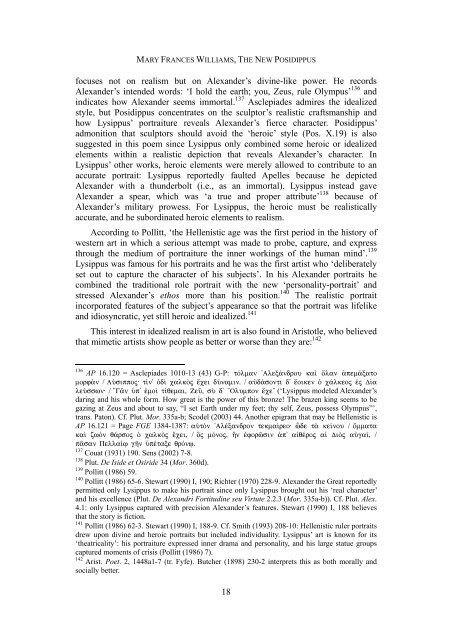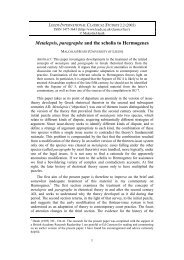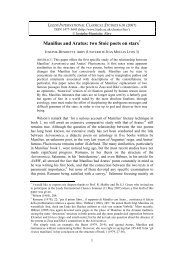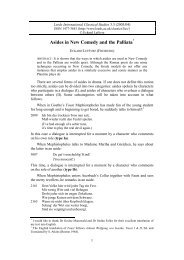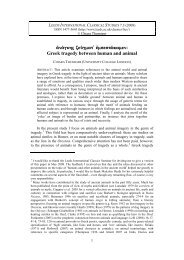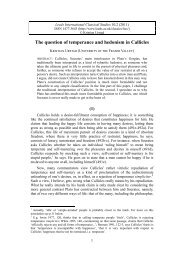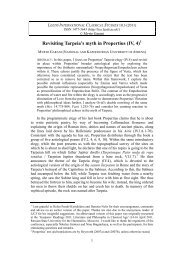The New Posidippus - Leeds International Classical Studies
The New Posidippus - Leeds International Classical Studies
The New Posidippus - Leeds International Classical Studies
You also want an ePaper? Increase the reach of your titles
YUMPU automatically turns print PDFs into web optimized ePapers that Google loves.
MARY FRANCES WILLIAMS, THE NEW POSIDIPPUS<br />
focuses not on realism but on Alexander’s divine-like power. He records<br />
Alexander’s intended words: ‘I hold the earth; you, Zeus, rule Olympus’ 136 and<br />
indicates how Alexander seems immortal. 137 Asclepiades admires the idealized<br />
style, but <strong>Posidippus</strong> concentrates on the sculptor’s realistic craftsmanship and<br />
how Lysippus’ portraiture reveals Alexander’s fierce character. <strong>Posidippus</strong>’<br />
admonition that sculptors should avoid the ‘heroic’ style (Pos. X.19) is also<br />
suggested in this poem since Lysippus only combined some heroic or idealized<br />
elements within a realistic depiction that reveals Alexander’s character. In<br />
Lysippus’ other works, heroic elements were merely allowed to contribute to an<br />
accurate portrait: Lysippus reportedly faulted Apelles because he depicted<br />
Alexander with a thunderbolt (i.e., as an immortal). Lysippus instead gave<br />
Alexander a spear, which was ‘a true and proper attribute’ 138 because of<br />
Alexander’s military prowess. For Lysippus, the heroic must be realistically<br />
accurate, and he subordinated heroic elements to realism.<br />
According to Pollitt, ‘the Hellenistic age was the first period in the history of<br />
western art in which a serious attempt was made to probe, capture, and express<br />
through the medium of portraiture the inner workings of the human mind’. 139<br />
Lysippus was famous for his portraits and he was the first artist who ‘deliberately<br />
set out to capture the character of his subjects’. In his Alexander portraits he<br />
combined the traditional role portrait with the new ‘personality-portrait’ and<br />
stressed Alexander’s ethos more than his position. 140 <strong>The</strong> realistic portrait<br />
incorporated features of the subject’s appearance so that the portrait was lifelike<br />
and idiosyncratic, yet still heroic and idealized. 141<br />
This interest in idealized realism in art is also found in Aristotle, who believed<br />
that mimetic artists show people as better or worse than they are: 142<br />
136 AP 16.120 = Asclepiades 1010-13 (43) G-P: tÒlman 'Alex£ndrou kaˆ Ólan ¢pem£xato<br />
morf¦n / LÚsippoj: t…n' Ðdˆ calkÕj œcei dÚnamin. / aÙd£sonti d' œoiken Ð c£lkeoj j D…a<br />
leÚsswn: / “G©n Øp' moˆ t…qemai, Zeà, sÝ d' ”Olumpon œce” (‘Lysippus modeled Alexander’s<br />
daring and his whole form. How great is the power of this bronze! <strong>The</strong> brazen king seems to be<br />
gazing at Zeus and about to say, “I set Earth under my feet; thy self, Zeus, possess Olympus”’,<br />
trans. Paton). Cf. Plut. Mor. 335a-b; Scodel (2003) 44. Another epigram that may be Hellenistic is<br />
AP 16.121 = Page FGE 1384-1387: aÙtÕn 'Alšxandron tekma…reo: ïde t¦ ke…nou / Ômmata<br />
kaˆ zwÕn q£rsoj Ð calkÕj œcei, / Öj mÒnoj, ¿n forîsin ¢p' a„qšroj aƒ DiÕj aÙga…, /<br />
p©san Pella…J gÁn Øpštaxe qrÒnJ.<br />
137 Couat (1931) 190. Sens (2002) 7-8.<br />
138 Plut. De Iside et Osiride 34 (Mor. 360d).<br />
139 Pollitt (1986) 59.<br />
140 Pollitt (1986) 65-6. Stewart (1990) I, 190; Richter (1970) 228-9. Alexander the Great reportedly<br />
permitted only Lysippus to make his portrait since only Lysippus brought out his ‘real character’<br />
and his excellence (Plut. De Alexandri Fortitudine seu Virtute 2.2.3 (Mor. 335a-b)). Cf. Plut. Alex.<br />
4.1: only Lysippus captured with precision Alexander’s features. Stewart (1990) I, 188 believes<br />
that the story is fiction.<br />
141 Pollitt (1986) 62-3. Stewart (1990) I, 188-9. Cf. Smith (1993) 208-10: Hellenistic ruler portraits<br />
drew upon divine and heroic portraits but included individuality. Lysippus’ art is known for its<br />
‘theatricality’: his portraiture expressed inner drama and personality, and his large statue groups<br />
captured moments of crisis (Pollitt (1986) 7).<br />
142 Arist. Poet. 2, 1448a1-7 (tr. Fyfe). Butcher (1898) 230-2 interprets this as both morally and<br />
socially better.<br />
18


